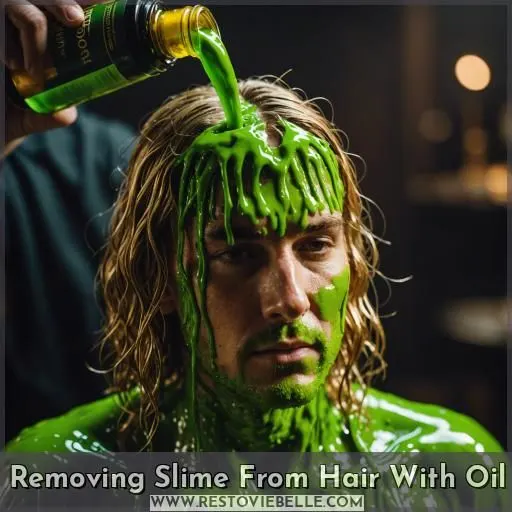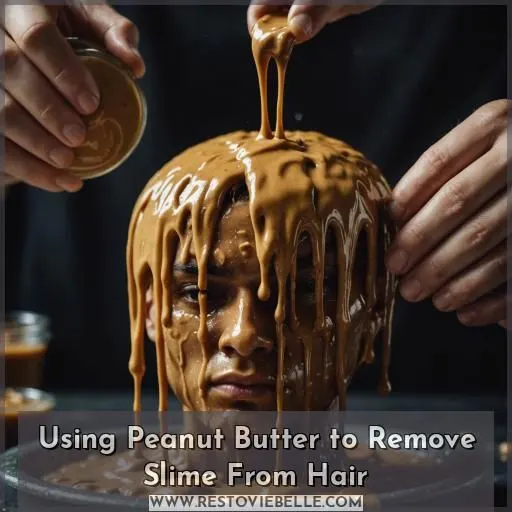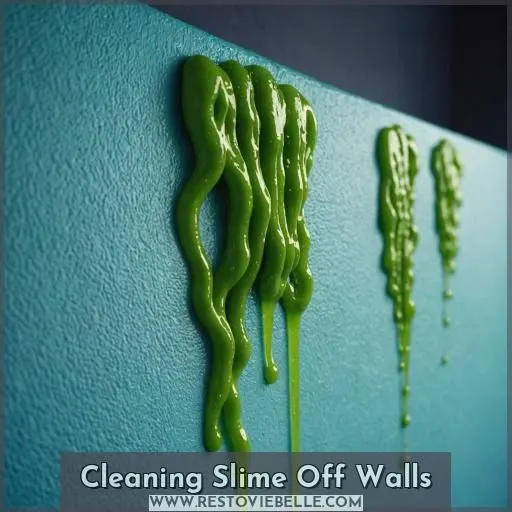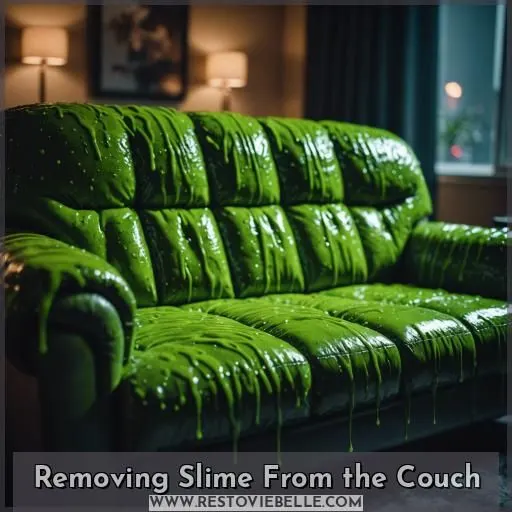This site is supported by our readers. We may earn a commission, at no cost to you, if you purchase through links.

Sticky slime in your hair? Don’t fret – you’ve got a few household items that can help. First, work some conditioner through the affected areas and rinse thoroughly. For stubborn slime, try applying a small amount of olive, coconut, or baby oil and gently massaging it in before rinsing.
Peanut butter or mayonnaise can also do the trick. Simply work it into the slime, let it sit for a few minutes, then rinse. By using these common household products, you can quickly banish that pesky slime from your hair.
If you’re looking to prevent slime mishaps in the future, keep reading to learn more.
Table Of Contents
- Key Takeaways
- How to Get Slime Out of Hair?
- How to Get Slime Out of Hair With Conditioner
- Removing Slime From Hair With Oil
- Using Peanut Butter to Remove Slime From Hair
- Getting Slime Out of Hair With Mayonnaise
- Can Vinegar or Coke Remove Slime From Hair?
- Preventing Slime From Getting Stuck in the First Place
- Cleaning Slime Off Walls
- Removing Slime From the Couch
- Getting Slime Out of Clothes
- Frequently Asked Questions (FAQs)
- Conclusion
Key Takeaways
- Use conditioner, oil, peanut butter, or mayonnaise to remove slime from hair effectively.
- Avoid harsh chemicals like vinegar or Coke, which can damage hair.
- Prevent slime from getting stuck in hair by using non-sticky slime recipes or opting for fluffy, cloud-like slimes.
- Clean slime off walls using a baking soda paste, and remove it from clothes with warm water and an oxygen-based bleach or rubbing alcohol.
How to Get Slime Out of Hair?
To get slime out of hair, common household items like conditioner, oil, or mayonnaise can be applied to break down the slime, followed by combing and washing with shampoo. These methods utilize the slippery nature of these substances to loosen the slime for easy removal.
How to Get Slime Out of Hair With Conditioner
When slime transforms your hair into a gooey nightmare, resist the urge to grab the shears! Conditioner, your bathroom essential, surprisingly vanquishes slime with ease. Its oil-based brilliance not only disentangles the mess but also lays the groundwork for slime resistance.
For a hassle-free play session, choose slime that doesn’t stick or is soft and fluffy. If conditioner falls short, culinary saviors like peanut butter or oil can come to the rescue, removing the tenacious slime and restoring your hair to its pristine condition.
Removing Slime From Hair With Oil
When slime strikes, oil’s your knight in shining armor. Its effectiveness lies in its slick nature, breaking up the goo without hair damage. Don’t fret over which oil to choose; olive, coconut, or baby oil—all work wonders.
Just drizzle your chosen oil on the slimy strands, massage gently, and comb through, from tips to roots. It’s a safe bet for preserving those precious locks.
Using Peanut Butter to Remove Slime From Hair
If you’re dealing with slime residue in your hair, don’t panic! Peanut butter can be your savior. This versatile kitchen staple has properties that make it an excellent alternative to commercial hair care products.
To use peanut butter for slime removal, apply a generous amount to your hair, focusing on the slime-affected areas. Use a comb to work it through your hair, breaking up the slime and moving upward.
After that, shampoo and rinse your hair thoroughly. Peanut butter is a natural hair treatment that can help you get rid of slime without damaging your hair.
Getting Slime Out of Hair With Mayonnaise
Mayonnaise is a popular household item that can be used to remove slime from hair. It’s known for its moisturizing properties, which can help dissolve the sticky substance. To use mayonnaise for this purpose, follow these steps:
- Apply: Gently massage a generous amount of mayonnaise into the slime-affected hair.
- Comb: Use a fine-tooth comb to gently remove the slime pieces, cleaning the comb as you go.
- Rinse: Once most of the slime has been removed, rinse the hair thoroughly to remove any remaining mayonnaise.
- Shampoo and condition: Follow up with a normal shampoo and conditioning routine to make sure the hair is clean and free of any residue.
If you prefer, you can also try using oil or peanut butter for the same purpose. These alternatives can be effective as well, but the process is similar to the mayonnaise method. Remember to be patient and gentle to avoid damaging the hair during the removal process.
Can Vinegar or Coke Remove Slime From Hair?
After tackling slime with mayonnaise, you might wonder about vinegar or Coke. Sure, both can cut through slime, but they’re not the kindest to your locks. Vinegar, while effective, can strip your hair of essential oils, and Coke, despite its cleaning prowess, might leave your hair feeling like a sticky soda spill.
Instead, sticking to gentler alternatives like oil or conditioner not only preserves hair health but also transforms a sticky situation into a smooth resolution without the harsh aftermath.
Preventing Slime From Getting Stuck in the First Place
Preventing slime from getting stuck in your hair is a game-changer. Start by using non-sticky slime recipes that are easy to follow and fun for kids. Create fluffy slime instead of regular slime.
If you’ve already got slime in your hair, try using oil or conditioner to remove it. For a quick fix, use peanut butter or mayonnaise. However, vinegar or Coke can make things worse.
To avoid future slime disasters, stick to safe, educational, and creative slime recipes. Always wash your hands before handling slime to keep your hair clean and tangle-free.
Cleaning Slime Off Walls
To remove slime from walls, follow these steps:
- Peel off the slime: If the slime is easily removable, use your fingers to gently peel it off the wall.
- Create a baking soda paste: Mix 4 tablespoons of baking soda, 1 tablespoon of water, and 1 tablespoon of vinegar to form a thick paste.
- Apply the paste: Use a damp sponge to apply the paste to the slime stain on the wall.
- Rub the paste: Gently rub the paste into the stain using the sponge.
- Let it sit: Allow the paste to sit on the stain for 10-15 minutes if the stain persists.
- Rinse the wall: Rinse the wall with water to remove the paste and the slime stain.
- Dry the wall: Dry the wall with a clean cloth or towel.
Remember to test the baking soda paste on a discreet area of the wall first to make sure it doesn’t damage the paint or wallpaper.
Removing Slime From the Couch
To remove slime from your couch, follow these steps:
- Remove excess slime: Use your fingers or a spoon to scrape off as much of the slime as possible. Be gentle to avoid damaging the fabric.
- Use vinegar solution: Mix equal parts white vinegar and water in a spray bottle. Spray the solution onto the slime stain and allow it to soak for a few minutes.
- Gently scrub: Use a soft bristle brush to work the solution into the upholstery fibers. Be sure to blot the area with a clean cloth to absorb any excess moisture.
- Repeat as needed: If the slime doesn’t come off completely, repeat the process until it’s gone. Remember to rinse the brush and cloth frequently to avoid spreading the slime.
- Dry the area: Once the slime is removed, let the area dry completely before using the couch again.
Getting Slime Out of Clothes
To remove slime from clothes, start by scraping off as much excess slime as possible using a spoon or butter knife. Then, soak the garment in a mixture of warm water and oxygen-based bleach (a plant-derived version of bleach) for one hour before washing.
Alternatively, you can use rubbing alcohol, which is best for white clothing as it has the potential to fade coloring. Pour a small amount of rubbing alcohol on the slime-stained area, let it sit for a few minutes, and then scrub the area with a small brush. Rinse the item with warm water before running it through the washing machine as normal.
If vinegar isn’t an option, you can also use dish soap. Squirt a generous amount of dish soap onto the slime before rubbing the cloth together under running water. Keep doing this until the slime is gone, and then wash as usual.
Remember to wash the garment as normal per the label instructions after removing the slime.
Frequently Asked Questions (FAQs)
Can I use other household items to remove slime from hair?
Try household staples like oil, peanut butter, or mayo to dissolve and remove stubborn slime. Just massage it in, comb it through, and rinse clean. No need to suffer a sticky situation.
How do I prevent slime from getting stuck in my hair?
To prevent slime from sticking in your hair, opt for non-sticky slime recipes. Fluffy, cloud-like slimes are easier to remove if they do get tangled. Steer clear of acidic slime-removers like vinegar or Coke – use oil instead to slide it right out.
Can I use vinegar or Coke to remove slime from my hair?
No, don’t use vinegar or Coke – they can dry out and damage your hair. Stick to gentler options like conditioner, oil, or peanut butter to safely remove stubborn slime from your locks.
How do I clean slime off walls?
Imagine your little one’s masterpiece on the pristine walls. No need to fret! Just peel off the excess, make a baking soda paste, scrub, and rinse – the wall’s good as new. Easy-peasy, right?
Can I use peanut butter to remove slime from my couch?
Peanut butter can indeed help remove stubborn slime from your couch. First, scoop up any excess slime, then rub a generous amount of peanut butter into the affected area. Let it sit for a few minutes before wiping it clean.
Conclusion
Removing sticky slime from hair might appear intimidating, but have no fear – the solution resides within your household items.
Whether you choose conditioner, oil, peanut butter, or mayonnaise, these ordinary ingredients can effectively eradicate that pesky slime, enabling you to restore your beautiful locks.














